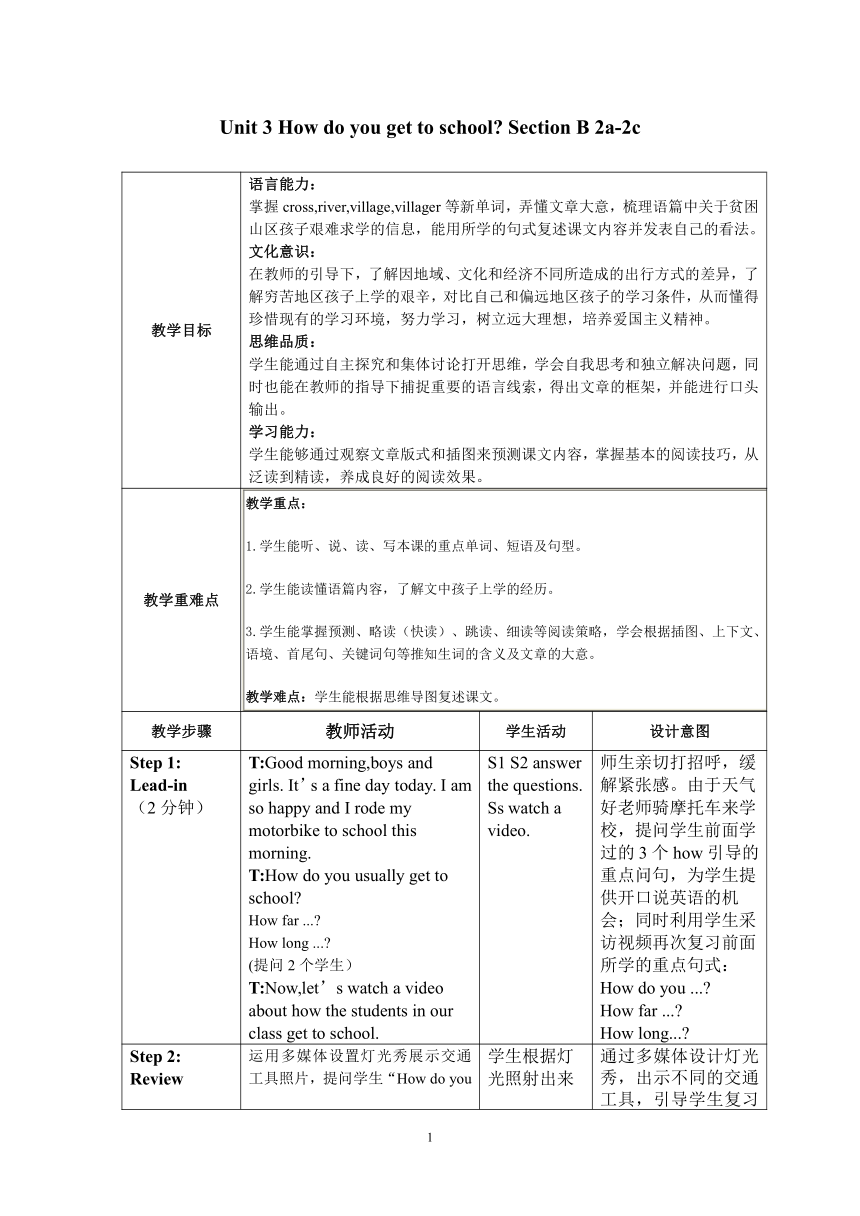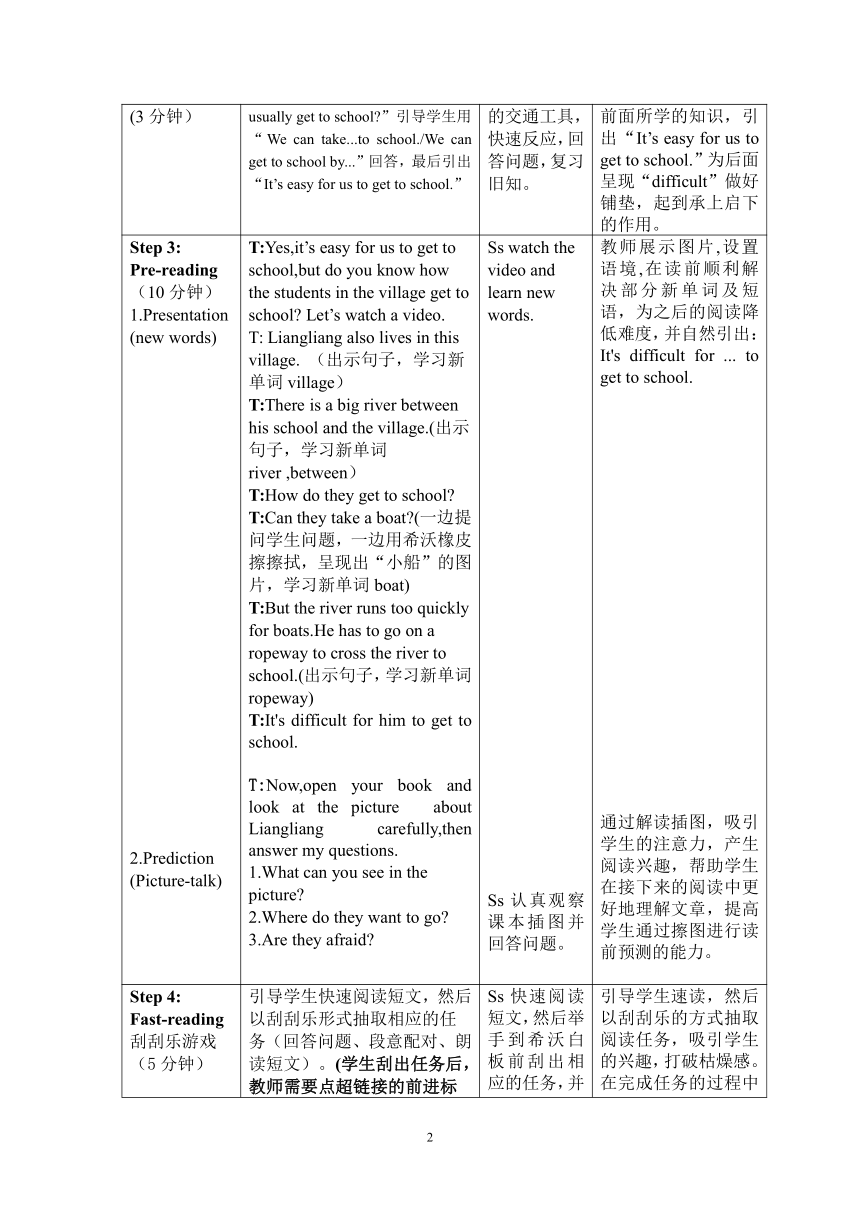Unit 3 How do you get to school ?Section B 2a-2c 教案(表格式)
文档属性
| 名称 | Unit 3 How do you get to school ?Section B 2a-2c 教案(表格式) |  | |
| 格式 | doc | ||
| 文件大小 | 50.0KB | ||
| 资源类型 | 教案 | ||
| 版本资源 | 人教新目标(Go for it)版 | ||
| 科目 | 英语 | ||
| 更新时间 | 2024-03-31 17:12:03 | ||
图片预览


文档简介
Unit 3 How do you get to school Section B 2a-2c
教学目标 语言能力:掌握cross,river,village,villager等新单词,弄懂文章大意,梳理语篇中关于贫困山区孩子艰难求学的信息,能用所学的句式复述课文内容并发表自己的看法。文化意识:在教师的引导下,了解因地域、文化和经济不同所造成的出行方式的差异,了解穷苦地区孩子上学的艰辛,对比自己和偏远地区孩子的学习条件,从而懂得珍惜现有的学习环境,努力学习,树立远大理想,培养爱国主义精神。思维品质:学生能通过自主探究和集体讨论打开思维,学会自我思考和独立解决问题,同时也能在教师的指导下捕捉重要的语言线索,得出文章的框架,并能进行口头输出。学习能力:学生能够通过观察文章版式和插图来预测课文内容,掌握基本的阅读技巧,从泛读到精读,养成良好的阅读效果。
教学重难点 教学重点:1.学生能听、说、读、写本课的重点单词、短语及句型。2.学生能读懂语篇内容,了解文中孩子上学的经历。3.学生能掌握预测、略读(快读)、跳读、细读等阅读策略,学会根据插图、上下文、语境、首尾句、关键词句等推知生词的含义及文章的大意。教学难点:学生能根据思维导图复述课文。
教学步骤 教师活动 学生活动 设计意图
Step 1:Lead-in(2分钟) T:Good morning,boys and girls. It’s a fine day today. I am so happy and I rode my motorbike to school this morning. T:How do you usually get to school How far ... How long ... (提问2个学生)T:Now,let’s watch a video about how the students in our class get to school. S1 S2 answer the questions.Ss watch a video. 师生亲切打招呼,缓解紧张感。由于天气好老师骑摩托车来学校,提问学生前面学过的3个how引导的重点问句,为学生提供开口说英语的机会;同时利用学生采访视频再次复习前面所学的重点句式:How do you ... How far ... How long...
Step 2:Review(3分钟) 运用多媒体设置灯光秀展示交通工具照片,提问学生“How do you usually get to school ”引导学生用“We can take...to school./We can get to school by...”回答,最后引出“It’s easy for us to get to school.” 学生根据灯光照射出来的交通工具,快速反应,回答问题,复习旧知。 通过多媒体设计灯光秀,出示不同的交通工具,引导学生复习前面所学的知识,引出“It’s easy for us to get to school.”为后面呈现“difficult”做好铺垫,起到承上启下的作用。
Step 3:Pre-reading(10分钟)1.Presentation(new words) 2.Prediction(Picture-talk) T:Yes,it’s easy for us to get to school,but do you know how the students in the village get to school Let’s watch a video.T: Liangliang also lives in this village. (出示句子,学习新单词village)T:There is a big river between his school and the village.(出示句子,学习新单词river ,between)T:How do they get to school T:Can they take a boat (一边提问学生问题,一边用希沃橡皮擦擦拭,呈现出“小船”的图片,学习新单词boat)T:But the river runs too quickly for boats.He has to go on a ropeway to cross the river to school.(出示句子,学习新单词ropeway)T:It's difficult for him to get to school.T:Now,open your book and look at the picture about Liangliang carefully,then answer my questions.1.What can you see in the picture 2.Where do they want to go 3.Are they afraid Ss watch the video and learn new words.Ss认真观察课本插图并回答问题。 教师展示图片,设置语境,在读前顺利解决部分新单词及短语,为之后的阅读降低难度,并自然引出:It's difficult for ... to get to school. 通过解读插图,吸引学生的注意力,产生阅读兴趣,帮助学生在接下来的阅读中更好地理解文章,提高学生通过擦图进行读前预测的能力。
Step 4:Fast-reading刮刮乐游戏(5分钟) 引导学生快速阅读短文,然后以刮刮乐形式抽取相应的任务(回答问题、段意配对、朗读短文)。(学生刮出任务后,教师需要点超链接的前进标志;学生完成任务后,教师需要点超链接的返回标志)T:Please read the passage quickly, then finish the tasks. Ss快速阅读短文,然后举手到希沃白板前刮出相应的任务,并完成。 引导学生速读,然后以刮刮乐的方式抽取阅读任务,吸引学生的兴趣,打破枯燥感。在完成任务的过程中渗透阅读策略,培养学生的阅读能力。
Step 5:Careful-reading(10分钟) Task 1:引导学生仔细阅读第一段,回答问题,渗透阅读策略。Q1.How do the students in the village get to school Q2.Why do they go to school like this Task 2:引导学生仔细阅读第一段,判断对错。T: Read the first paragraph carefully and finish the task.(True or False)T:Before reading,I'd like to share some reading skills with you.Task 3:引导学生阅读2.3段,回答问题,出示阅读策略。Q1.Does Liangliang like his school Why Q2.What's the villagers' dream Ss齐读阅读技巧,完成阅读任务。S1 S2说出自己的答案并分享解题技巧。Ss 齐读老师出示的阅读技巧。Ss仔细阅读短文第二、三段,完成问题。 引导学生分段细读,每段设计的问题层层递进,由浅入深地引导学生一步步理解课文,培养学生通过分析短文,提取、梳理信息,画出首尾句或关键词句的阅读策略,提高学生的阅读能力。(阅读技巧的训练)
Step 6:Post-reading(10分钟) Task 1:Complete the sentences with words from the passage and role -play the conversation.(让学生1分钟完成2c填空,并利用希沃白板5手机端同步授课,投屏一位学生的答案,然后邀请两组学生角色扮演对话。)Task 2:Retell(Group work)Let Ss retell the story . Ss完成2c填空,并与同桌角色扮演2c对话。三人一个小组,根据思维导图互相retell。(抽两个同学上台retell) 通过完成2c,巩固强化课文内容,训练学生口语能力。通过小组活动进行retell,训练学生的口头表达能力,培养学生互帮互助的能力。
Step 7:Think and say(情感教育) (2分钟) Let Ss watch a video.T:Do you think the students and villagers' dream can come true What can you do to help them T:Let's watch a video.(关于我国脱贫攻坚成果的视频) 观看视频,思考并回答问题。 通过观看视频,让学生了解我国脱贫攻坚成果,增强民族自豪感,提升社会责任感,懂得珍惜今天的学习条件及幸福生活,努力学习。
Step 8:Summary(2分钟) 引导学生根据思维导图总结本节课所学内容。(引导学生自主总结本课所学的重点词汇、短语及句型等,再出示课件) 根据思维导图总结本节课所学内容。 以思维导图的形式总结,简单明了,有利于学生在脑海中快速形成自己的知识脉络。
Step 9:Homework(1分钟) If you are Liangliang, try to write a letter to a newspaper to ask for help.1. Where do you live 2. What time do you get up 3. How do you get to school Why 4. How long does it take 5. How far is it from your home to school 6. Are you afraid 7. What's vour dream 学生记下作业 布置学生写,作业2让学生利用目标语言进行对话,训练学生的口语能力、写作能力及综合运用语言的能力。
PAGE
3
教学目标 语言能力:掌握cross,river,village,villager等新单词,弄懂文章大意,梳理语篇中关于贫困山区孩子艰难求学的信息,能用所学的句式复述课文内容并发表自己的看法。文化意识:在教师的引导下,了解因地域、文化和经济不同所造成的出行方式的差异,了解穷苦地区孩子上学的艰辛,对比自己和偏远地区孩子的学习条件,从而懂得珍惜现有的学习环境,努力学习,树立远大理想,培养爱国主义精神。思维品质:学生能通过自主探究和集体讨论打开思维,学会自我思考和独立解决问题,同时也能在教师的指导下捕捉重要的语言线索,得出文章的框架,并能进行口头输出。学习能力:学生能够通过观察文章版式和插图来预测课文内容,掌握基本的阅读技巧,从泛读到精读,养成良好的阅读效果。
教学重难点 教学重点:1.学生能听、说、读、写本课的重点单词、短语及句型。2.学生能读懂语篇内容,了解文中孩子上学的经历。3.学生能掌握预测、略读(快读)、跳读、细读等阅读策略,学会根据插图、上下文、语境、首尾句、关键词句等推知生词的含义及文章的大意。教学难点:学生能根据思维导图复述课文。
教学步骤 教师活动 学生活动 设计意图
Step 1:Lead-in(2分钟) T:Good morning,boys and girls. It’s a fine day today. I am so happy and I rode my motorbike to school this morning. T:How do you usually get to school How far ... How long ... (提问2个学生)T:Now,let’s watch a video about how the students in our class get to school. S1 S2 answer the questions.Ss watch a video. 师生亲切打招呼,缓解紧张感。由于天气好老师骑摩托车来学校,提问学生前面学过的3个how引导的重点问句,为学生提供开口说英语的机会;同时利用学生采访视频再次复习前面所学的重点句式:How do you ... How far ... How long...
Step 2:Review(3分钟) 运用多媒体设置灯光秀展示交通工具照片,提问学生“How do you usually get to school ”引导学生用“We can take...to school./We can get to school by...”回答,最后引出“It’s easy for us to get to school.” 学生根据灯光照射出来的交通工具,快速反应,回答问题,复习旧知。 通过多媒体设计灯光秀,出示不同的交通工具,引导学生复习前面所学的知识,引出“It’s easy for us to get to school.”为后面呈现“difficult”做好铺垫,起到承上启下的作用。
Step 3:Pre-reading(10分钟)1.Presentation(new words) 2.Prediction(Picture-talk) T:Yes,it’s easy for us to get to school,but do you know how the students in the village get to school Let’s watch a video.T: Liangliang also lives in this village. (出示句子,学习新单词village)T:There is a big river between his school and the village.(出示句子,学习新单词river ,between)T:How do they get to school T:Can they take a boat (一边提问学生问题,一边用希沃橡皮擦擦拭,呈现出“小船”的图片,学习新单词boat)T:But the river runs too quickly for boats.He has to go on a ropeway to cross the river to school.(出示句子,学习新单词ropeway)T:It's difficult for him to get to school.T:Now,open your book and look at the picture about Liangliang carefully,then answer my questions.1.What can you see in the picture 2.Where do they want to go 3.Are they afraid Ss watch the video and learn new words.Ss认真观察课本插图并回答问题。 教师展示图片,设置语境,在读前顺利解决部分新单词及短语,为之后的阅读降低难度,并自然引出:It's difficult for ... to get to school. 通过解读插图,吸引学生的注意力,产生阅读兴趣,帮助学生在接下来的阅读中更好地理解文章,提高学生通过擦图进行读前预测的能力。
Step 4:Fast-reading刮刮乐游戏(5分钟) 引导学生快速阅读短文,然后以刮刮乐形式抽取相应的任务(回答问题、段意配对、朗读短文)。(学生刮出任务后,教师需要点超链接的前进标志;学生完成任务后,教师需要点超链接的返回标志)T:Please read the passage quickly, then finish the tasks. Ss快速阅读短文,然后举手到希沃白板前刮出相应的任务,并完成。 引导学生速读,然后以刮刮乐的方式抽取阅读任务,吸引学生的兴趣,打破枯燥感。在完成任务的过程中渗透阅读策略,培养学生的阅读能力。
Step 5:Careful-reading(10分钟) Task 1:引导学生仔细阅读第一段,回答问题,渗透阅读策略。Q1.How do the students in the village get to school Q2.Why do they go to school like this Task 2:引导学生仔细阅读第一段,判断对错。T: Read the first paragraph carefully and finish the task.(True or False)T:Before reading,I'd like to share some reading skills with you.Task 3:引导学生阅读2.3段,回答问题,出示阅读策略。Q1.Does Liangliang like his school Why Q2.What's the villagers' dream Ss齐读阅读技巧,完成阅读任务。S1 S2说出自己的答案并分享解题技巧。Ss 齐读老师出示的阅读技巧。Ss仔细阅读短文第二、三段,完成问题。 引导学生分段细读,每段设计的问题层层递进,由浅入深地引导学生一步步理解课文,培养学生通过分析短文,提取、梳理信息,画出首尾句或关键词句的阅读策略,提高学生的阅读能力。(阅读技巧的训练)
Step 6:Post-reading(10分钟) Task 1:Complete the sentences with words from the passage and role -play the conversation.(让学生1分钟完成2c填空,并利用希沃白板5手机端同步授课,投屏一位学生的答案,然后邀请两组学生角色扮演对话。)Task 2:Retell(Group work)Let Ss retell the story . Ss完成2c填空,并与同桌角色扮演2c对话。三人一个小组,根据思维导图互相retell。(抽两个同学上台retell) 通过完成2c,巩固强化课文内容,训练学生口语能力。通过小组活动进行retell,训练学生的口头表达能力,培养学生互帮互助的能力。
Step 7:Think and say(情感教育) (2分钟) Let Ss watch a video.T:Do you think the students and villagers' dream can come true What can you do to help them T:Let's watch a video.(关于我国脱贫攻坚成果的视频) 观看视频,思考并回答问题。 通过观看视频,让学生了解我国脱贫攻坚成果,增强民族自豪感,提升社会责任感,懂得珍惜今天的学习条件及幸福生活,努力学习。
Step 8:Summary(2分钟) 引导学生根据思维导图总结本节课所学内容。(引导学生自主总结本课所学的重点词汇、短语及句型等,再出示课件) 根据思维导图总结本节课所学内容。 以思维导图的形式总结,简单明了,有利于学生在脑海中快速形成自己的知识脉络。
Step 9:Homework(1分钟) If you are Liangliang, try to write a letter to a newspaper to ask for help.1. Where do you live 2. What time do you get up 3. How do you get to school Why 4. How long does it take 5. How far is it from your home to school 6. Are you afraid 7. What's vour dream 学生记下作业 布置学生写,作业2让学生利用目标语言进行对话,训练学生的口语能力、写作能力及综合运用语言的能力。
PAGE
3
同课章节目录
- Unit 1 Can you play the guitar?
- Section A
- Section B
- Unit 2 What time do you go to school?
- Section A
- Section B
- Unit 3 How do you get to school?
- Section A
- Section B
- Unit 4 Don't eat in class.
- Section A
- Section B
- Unit 5 Why do you like pandas?
- Section A
- Section B
- Unit 6 I'm watching TV.
- Section A
- Section B
- Review of Units 1-6
- Unit 7 It's raining!
- Section A
- Section B
- Unit 8 Is there a post office near here?
- Section A
- Section B
- Unit 9 What does he look like?
- Section A
- Section B
- Unit 10 I'd like some noodles.
- Section A
- Section B
- Unit 11 How was your school trip?
- Section A
- Section B
- Unit 12 What did you do last weekend?
- Section A
- Section B
